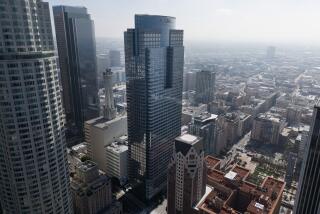Conversation With Richard Moore and Blenda J. Wilson : 2 Schools Hit by Quake Try to Get It Together
Question: What was the effect of the Northridge earthquake on your campus?
Moore: The three-floor science building, which also housed our central computer and telephone system, was lifted at its north end and thrown south. It had 350 broken windows.
Next door, 200 windows were blown out in the liberal arts building; in the next week, the building was banged apart. We lost 40 classrooms and labs and one parking structure. In our business building, water heaters on the roof broke and flooded, bringing the ceilings down two floors.
Wilson: All 53 buildings (at Northridge) were affected to some degree. A dozen major buildings--generally the tallest ones--had significant damage. A parking structure collapsed. A chemical fire burned out two floors of a science building.
The impact on operations was extreme. In those buildings were computers, faxes, copy machines. Since none of our buildings can be occupied yet, we’re operating from tents and trailers.
Q: How much rebuilding is needed?
Moore: Santa Monica probably has $26 million in damage--$15 million to rebuild the science building, which everybody agrees is a goner.
Wilson: We’ll need to rebuild a lot, but no entire buildings, with the possible exception of the south library, which is unsound. That parking structure will need to be picked up and taken away. We’ve already taken down the 42-ton pedestrian bridges between science buildings because they’ve become unstable; removed the tower section of Sierra Hall, an eight-story building, and pulled most of the debris off Oviatt library, which looks bad cosmetically, but is structurally sound.
The cost? We don’t know. In addition to restoration, the 300 trailers we brought on campus for classrooms and offices cost something like $1 million a month; the hazardous materials people cost $15,000 a day; the asbestos removal costs $25,000 a day. It easily puts us in the $250-$300 million range.
Q: Can the schools function?
Wilson: Spring term will be starting Feb. 14, two weeks later than scheduled; we expect 22,000 students--17,000 of them registered before the earthquake. W’ve made arrangements for students who lost their off-campus housing to attend CSU campuses near their families’ homes.
We’ll have trailers all around campus and eight or nine buildings fixed up for offices and programs like student union, student health, athletics.
Fortunately, we always made backup tapes of computer records and stored them in the old south library. All our student records are now on the computers at Cal State Fresno, which is running our registration.
Moore: We expect 24,000 students in mid-February for the 16-week spring semester. We pushed that opening up a week to Feb. 22. The college is running. Our central computer fell over, but we just stood it up and it went on working. We’ve organized a mobile classroom village, including chemistry and biology labs, on the tennis courts.
Q: Have you any other alternatives?
Moore: We have a rented building at the Santa Monica Airport and half of an unused elementary school. People can also park at the airport and be shuttled to the campus. The city owns a light-rail junction point on Olympic that it would rent us for an educational village. Various schools--St. Monica High, Santa Monica Unified, Crossroads--have offered the use of rooms at night. This is a very cooperative town.
Wilson: The response has been very generous. We have offers of space at Valley College, Pierce, Mission and Pepperdine’s continuing-education center in Northridge. Commercial enterprises have offered mostly skills or supplies. Hughes, for example, gave us several hundred desks and chairs, and Pacific Bell gave us free cellular phones.
Q: Might the earthquake even lead to good arrangements?
Moore: Yes. There needs to be new partnerships in higher education, particularly among tax-supported institutions. Maybe we should try to get state and private monies to build “educational villages” which provide everything from job training to master’s degrees.
Wilson: We are beginning to talk about potential for long-range collaboration with Santa Monica. The intellectual excitement beyond the drudgery is to figure out how to do some things better than before.
Q: How are you holding up personally?
Moore: I live in Santa Monica Canyon. We lost the fireplace, chimney and dishes, but our three children are OK.
Wilson: I live a mile and a half from campus in a university-owned home. Every glass and cabinet that could break did--including two toilets and the solar panels, but my husband and I were not hurt and the house is OK.
Q: Why not just close while you rebuild?
Wilson: This university, unlike a full-time residence college, is central to the Tri-Valley region: our students are citizens and employees, and the recovery of the community and the recovery of the university are interdependent.
Moore: In community colleges, we put together dreams and hopes that people haven’t had in years; we’re not going to shelve them because of fire or flood. Success doesn’t require genius, but passion, endurance, dreams and hard work. There are fewer and fewer school opportunities; we’re committed to not slowing down anyone’s education.
More to Read
Sign up for Essential California
The most important California stories and recommendations in your inbox every morning.
You may occasionally receive promotional content from the Los Angeles Times.










